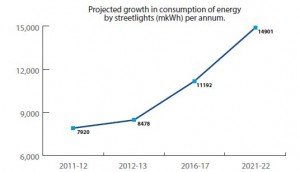 Shakti Datta, Country Manager(India) of Canadian company LED Roadway Lighting outlines some of the key considerations for designing, planning, and deploying LED smart street lighting in India.
Shakti Datta, Country Manager(India) of Canadian company LED Roadway Lighting outlines some of the key considerations for designing, planning, and deploying LED smart street lighting in India.
India is seeking to enhance its infrastructure through some major initiatives supported by the Prime Minister. One of these initiatives is to convert 32 million existing streetlights (high pressure sodium & low pressure sodium) to LED technology within a 3 – 5 year period. As the statistics highlight, there is a great opportunity and payback incentive for India to embark upon the initiative of converting inefficient traditional street lighting to smarter and more energy efficient solid-state LED street lights.
Key Statistics
- Significant growth of 8.50 billion kWh of power was consumed annually between 2012 – 2013. Keep in mind that this figure is growing at compound annual growth rate (CAGR) of 7%.
- By converting to LED street lighting the potential for energy savings can be as high as 60%.
- An additional 10 – 25% energy savings can be achieved through the use of adaptive controls and central management software (e.g. lumen optimization, scheduling, etc.).
- There is a potential for a nation-wide savings of 5 billion kWh / annum.
- Cost savings of more than Rs.3000Cr
Challenges

Figure 1 Projected Growth In Consumption Of Energy By Streetlights (Mkwh) Per Annum. Source: Pricewaterhouse Coopers Inc.
Public lighting operations through the Public-Private Partnership (PPP) mode can have several challenges. The first challenge is overcoming inadequate data availability. Billing can also be a problematic issue as there is often a wide variation in billed load vs actual load (30 – 50%) due to un-metered points and slow metering, etc. Manual operation leads to variation in operating hours resulting in additional usage of 10 – 15%. Another challenge is inadequacies in the payment mechanism that leads to increased cost of capital and viability. Lastly, there are monitoring and verification (M&V) challenges. A detailed M&V plan, in the current situation, makes it very difficult for an energy saving company to arrange finance.
Trends in LED Street Lighting
The street light market is currently undergoing a dramatic period of change. Legacy streetlights are being replaced with more efficient LED lighting technology. In addition, LED streetlights when integrated into a Smart Grid / Smart City network can gain valuable communication capabilities therefore allowing the end-user to have much greater control and management of their lighting infrastructure. In India, LED specifications do not include compatibility with smart networks and a provision for NEMA receptacle (internationally accredited plug standard), and/or a power supply capable of dimming.
LED technology has a far greater correlated colour temperature (CCT) rating than traditional lighting sources. This is crucial when color rendering is considered important. Customers are also in need of future-proofed technology and modular designs that allows for future advancements in technology. Customers are identifying the need for a higher quality product (This may need a mindset shift to transition from L1 to T1 in the bidding process).
Shift in Cost Paradigm

Figure 2: India – State Wise Electricity Consumption In Public Lighting. Source: Pricewaterhouse Coopers Inc
Some existing projects in India have noticed a high failure rate with unit price based models. Customers are starting to change the way they think about the cost of LED luminaires. We now look at the whole picture and take into account overall life-cycle costs for a 20-year period (energy, maintenance, capital, and return on investment). These costs also include energy cost and warranty in procurement. The old model was commodity based and the calculation was based on unit price only. The new model is based on life-cycle costs (See figure 3).
 TrafficInfraTech Magazine Linking People Places & Progress
TrafficInfraTech Magazine Linking People Places & Progress